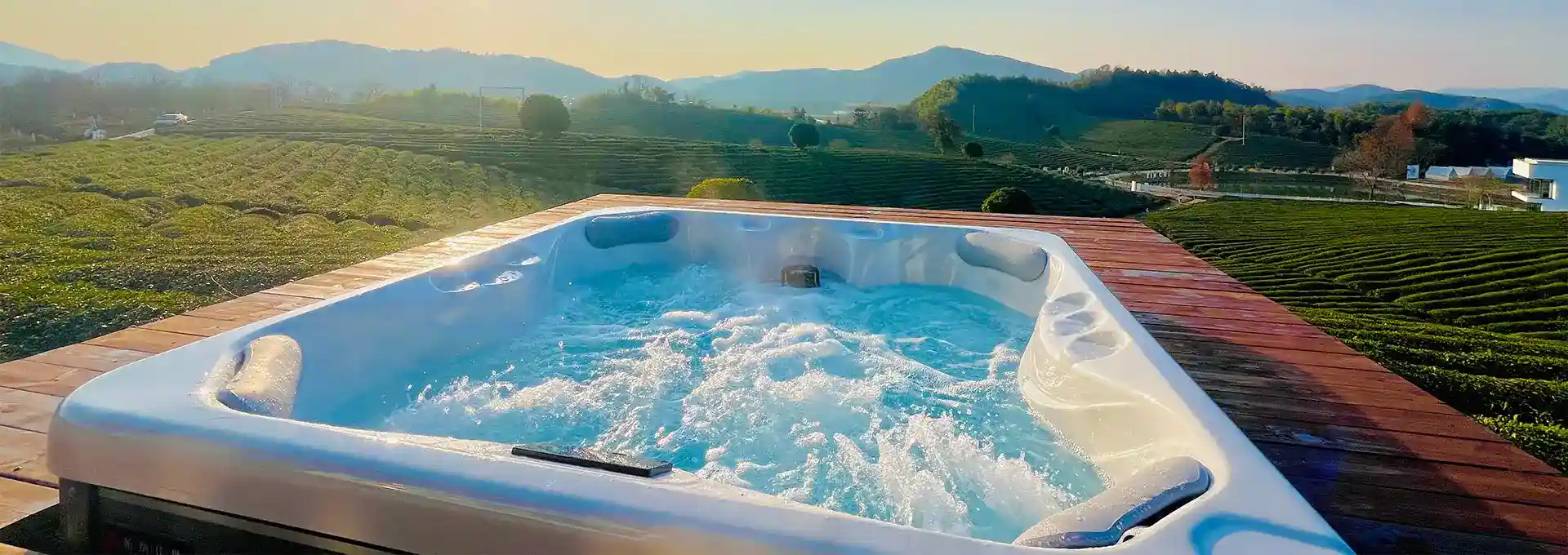How to Winterize a Jacuzzi Hot Tub?
2025-02-24 14:46:36
As the temperatures drop and winter approaches, it's crucial to properly winterize your Jacuzzi hot tub to protect it from potential damage caused by freezing temperatures and harsh weather conditions. Winterizing your hot tub not only safeguards your investment but also ensures that it's ready for use when spring arrives. In this comprehensive guide, we'll walk you through the essential steps to winterize your Jacuzzi hot tub effectively, addressing common questions and concerns along the way.
What are the steps to drain a Jacuzzi hot tub for winter?
Draining your Jacuzzi hot tub is the first and most critical step in the winterization process. Here's a detailed guide on how to properly drain your hot tub:
- Turn off the power: Before you begin, ensure that the hot tub is completely disconnected from its power source. This step is crucial for safety and to prevent any damage to the electrical components.
- Locate the drain valve: Most Jacuzzi hot tubs have a main drain valve located at the base of the tub. Consult your owner's manual if you're having trouble finding it.
- Attach a garden hose: Connect a garden hose to the drain valve. Make sure the other end of the hose is placed in an area where the water can safely drain away from your property.
- Open the drain valve: Once the hose is securely attached, open the drain valve to allow the water to start flowing out. This process can take several hours, depending on the size of your hot tub.
- Remove the drain plug: While the main valve is draining, locate and remove the drain plug inside the hot tub. This will help the water drain more quickly and completely.
- Use a submersible pump: To speed up the draining process and remove water from hard-to-reach areas, consider using a submersible pump. Place the pump in the footwell of the hot tub and let it run until most of the water is removed.
- Remove remaining water: Use a wet/dry vacuum or sponges to remove any remaining water from the jets, crevices, and footwell. Pay special attention to low points where water might collect.
- Clean the shell: While the tub is empty, take this opportunity to clean the shell thoroughly. Use a non-abrasive cleaner specifically designed for hot tubs to remove any dirt, grime, or scale buildup.
- Clean and remove filters: Remove the filters from your hot tub, clean them thoroughly, and store them in a dry place for the winter. This will help extend their lifespan and ensure they're ready for use in the spring.
- Blow out the lines: Use a shop vac or specialized blower to force any remaining water out of the plumbing lines. This step is crucial to prevent freezing and potential damage to the pipes.
Remember, thorough draining is essential to prevent any water from freezing and expanding within the tub's components, which could lead to costly repairs come spring.
How do you winterize a Jacuzzi hot tub without draining it?
While it's generally recommended to drain your Jacuzzi hot tub for winter, there are situations where you might choose to keep it filled. This method is often referred to as "wet winterizing" and is suitable for milder climates or if you plan to use the hot tub occasionally during winter. Here's how to winterize your Jacuzzi hot tub without draining it:
- Maintain water chemistry: Continue to test and balance the water regularly, even if you're not using the hot tub frequently. Proper pH, alkalinity, and sanitizer levels will prevent bacterial growth and protect the tub's components.
- Keep the water circulating: Set your hot tub to run its circulation cycles regularly. This constant movement helps prevent the water from freezing, even in cold temperatures.
- Insulate the cabinet: Add extra insulation around the cabinet of your hot tub to help retain heat and protect the plumbing. You can use foam boards or specialized hot tub blankets for this purpose.
- Use a floating de-icer: For added protection against freezing, consider using a floating de-icer. This device will activate when water temperatures approach freezing, providing additional heat to prevent ice formation.
- Cover properly: Ensure your hot tub cover is in good condition and fits snugly. A well-fitted cover will help retain heat and prevent debris from entering the water. Consider using a thermal blanket underneath the main cover for extra insulation.
- Monitor the temperature: Set your hot tub to maintain a temperature of at least 50°F (10°C). This is warm enough to prevent freezing but cool enough to minimize energy costs if you're not using the tub regularly.
- Check regularly: Even if you're not using the hot tub, make it a habit to check on it at least once a week. Look for any signs of freezing or malfunction in the system.
- Prepare for power outages: In case of a power outage, have a plan in place to prevent freezing. This might include a backup generator or a method to quickly drain the tub if necessary.
- Clean and maintain: Continue to clean the filters and perform regular maintenance tasks. This will ensure that your hot tub remains in good condition throughout the winter.
- Consider a freeze protection system: Some hot tubs come with built-in freeze protection systems. If yours doesn't have one, consider installing an aftermarket system for added peace of mind.
While wet winterizing can be convenient, it's important to note that this method requires more ongoing attention and energy use compared to fully draining the tub. If you live in an area prone to extended periods of freezing temperatures or frequent power outages, draining the hot tub might still be the safer option.
What temperature should a hot tub be set at in winter?
Setting the right temperature for your Jacuzzi hot tub during winter is crucial for both enjoyment and energy efficiency. The ideal temperature can vary depending on your usage patterns and personal preferences, but here are some general guidelines and considerations:
- Regular use temperature: If you plan to use your hot tub regularly throughout the winter, maintaining a temperature between 100°F and 104°F (38°C to 40°C) is ideal. This range provides a comfortable soaking experience while being energy-efficient.
- Energy-saving temperature: If you use your hot tub less frequently during winter, consider lowering the temperature to around 95°F to 98°F (35°C to 37°C) when not in use. This can help reduce energy costs while still keeping the water warm enough to prevent freezing.
- Minimum winter temperature: For hot tubs that are not being used but are kept filled (wet winterized), maintain a minimum temperature of 50°F to 60°F (10°C to 15°C). This is warm enough to prevent freezing while minimizing energy consumption.
- Gradual temperature changes: When adjusting the temperature, do so gradually. Rapid temperature changes can stress the hot tub's components and affect water chemistry.
- Consider ambient temperature: In extremely cold climates, you may need to set the temperature slightly higher to compensate for heat loss. Monitor your hot tub's performance and adjust accordingly.
- Use a thermal blanket: Adding a thermal blanket under your hot tub cover can help retain heat, allowing you to maintain a lower temperature setting without compromising comfort.
- Smart temperature control: Some modern Jacuzzi hot tubs come with smart temperature control features. These can automatically adjust the temperature based on usage patterns and weather conditions, optimizing energy efficiency.
- Pre-heating considerations: If you've lowered the temperature to save energy, remember to allow sufficient time for the water to heat up before use. Most hot tubs heat at a rate of about 3-6 degrees per hour.
- Safety first: Regardless of the outside temperature, never set your hot tub higher than 104°F (40°C). Higher temperatures can be dangerous, especially for extended soaking sessions.
- Personal comfort: While these guidelines provide a good starting point, personal preference plays a significant role. Some users might prefer slightly cooler or warmer temperatures. Experiment to find what works best for you while keeping energy efficiency in mind.
Remember that maintaining a consistent temperature is often more energy-efficient than allowing the water to cool significantly and then reheating it. However, if you're going to be away for an extended period or don't plan to use the hot tub for several weeks, lowering the temperature can help save on energy costs.
Proper temperature management during winter not only ensures a comfortable soaking experience but also plays a crucial role in protecting your Jacuzzi hot tub from potential cold-weather damage. By finding the right balance between comfort, usage, and energy efficiency, you can enjoy your hot tub throughout the winter months while minimizing operational costs and potential wear on your system.
Conclusion
Winterizing your Jacuzzi hot tub is an essential maintenance task that protects your investment and ensures you can enjoy your spa for years to come. Whether you choose to fully drain your hot tub or maintain it filled during the winter months, following these guidelines will help you navigate the process with confidence. Remember to always consult your specific Jacuzzi model's manual for any unique winterization requirements, and don't hesitate to seek professional help if you're unsure about any step of the process. With proper care and attention, your Jacuzzi hot tub will be ready to provide relaxation and enjoyment as soon as the warmer weather returns.
For more information on Jacuzzi hot tub installations and our products, please feel free to contact us at info@iparnassus.com.
References
- Jacuzzi. (2023). Hot Tub Winterization Guide. Retrieved from https://www.jacuzzi.com/en-us/hot-tubs/owners/care-and-maintenance/winterization
- Swim University. (2023). How To Winterize An Inground Pool in 13 Steps. Retrieved from https://www.swimuniversity.com/winterize-pool/
- Hot Spring Spas. (2023). How to Winterize a Hot Tub. Retrieved from https://www.hotspring.com/hot-tub-wellness-blog/how-to-winterize-a-hot-tub
- Leslie's Pool Supplies. (2023). How to Winterize Your Above Ground Pool. Retrieved from https://lesliespool.com/blog/how-to-winterize-your-above-ground-pool.html
- Master Spas. (2023). Hot Tub Winterization: To Drain or Not to Drain. Retrieved from https://www.masterspas.com/blog/hot-tub-winterization/
- Bullfrog Spas. (2023). Winter Hot Tub Maintenance. Retrieved from https://www.bullfrogspas.com/hot-tub-blog/winter-hot-tub-maintenance/
- Caldera Spas. (2023). How to Winterize a Hot Tub. Retrieved from https://www.calderaspas.com/hot-tub-blog/how-winterize-hot-tub
- Arctic Spas. (2023). Winterizing Your Hot Tub. Retrieved from https://www.arcticspas.com/hot-tub-information/maintenance/winterizing-your-hot-tub/
- Hayward Pool Products. (2023). How to Winterize Your Pool. Retrieved from https://www.hayward-pool.com/shop/en/pools/how-to-winterize-your-pool
- Endless Pools. (2023). How to Winterize Your Endless Pool. Retrieved from https://www.endlesspools.com/blog/how-to-winterize-your-endless-pool



